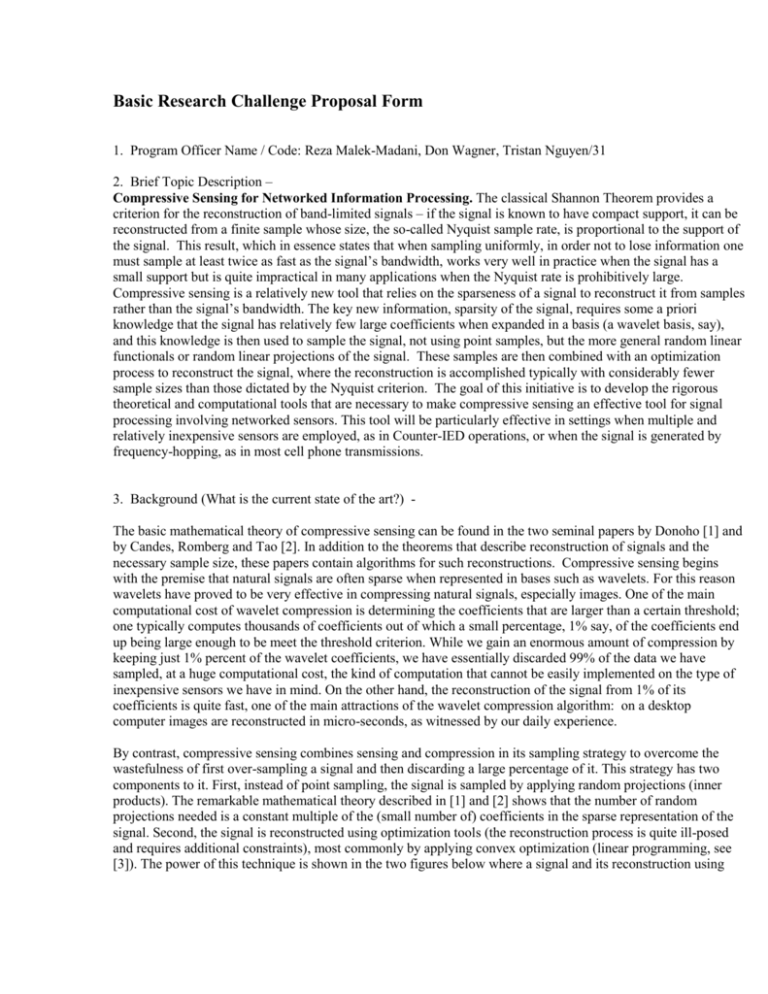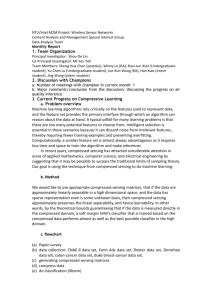Form for Basic Research Challenge Topic
advertisement

Basic Research Challenge Proposal Form 1. Program Officer Name / Code: Reza Malek-Madani, Don Wagner, Tristan Nguyen/31 2. Brief Topic Description – Compressive Sensing for Networked Information Processing. The classical Shannon Theorem provides a criterion for the reconstruction of band-limited signals – if the signal is known to have compact support, it can be reconstructed from a finite sample whose size, the so-called Nyquist sample rate, is proportional to the support of the signal. This result, which in essence states that when sampling uniformly, in order not to lose information one must sample at least twice as fast as the signal’s bandwidth, works very well in practice when the signal has a small support but is quite impractical in many applications when the Nyquist rate is prohibitively large. Compressive sensing is a relatively new tool that relies on the sparseness of a signal to reconstruct it from samples rather than the signal’s bandwidth. The key new information, sparsity of the signal, requires some a priori knowledge that the signal has relatively few large coefficients when expanded in a basis (a wavelet basis, say), and this knowledge is then used to sample the signal, not using point samples, but the more general random linear functionals or random linear projections of the signal. These samples are then combined with an optimization process to reconstruct the signal, where the reconstruction is accomplished typically with considerably fewer sample sizes than those dictated by the Nyquist criterion. The goal of this initiative is to develop the rigorous theoretical and computational tools that are necessary to make compressive sensing an effective tool for signal processing involving networked sensors. This tool will be particularly effective in settings when multiple and relatively inexpensive sensors are employed, as in Counter-IED operations, or when the signal is generated by frequency-hopping, as in most cell phone transmissions. 3. Background (What is the current state of the art?) The basic mathematical theory of compressive sensing can be found in the two seminal papers by Donoho [1] and by Candes, Romberg and Tao [2]. In addition to the theorems that describe reconstruction of signals and the necessary sample size, these papers contain algorithms for such reconstructions. Compressive sensing begins with the premise that natural signals are often sparse when represented in bases such as wavelets. For this reason wavelets have proved to be very effective in compressing natural signals, especially images. One of the main computational cost of wavelet compression is determining the coefficients that are larger than a certain threshold; one typically computes thousands of coefficients out of which a small percentage, 1% say, of the coefficients end up being large enough to be meet the threshold criterion. While we gain an enormous amount of compression by keeping just 1% percent of the wavelet coefficients, we have essentially discarded 99% of the data we have sampled, at a huge computational cost, the kind of computation that cannot be easily implemented on the type of inexpensive sensors we have in mind. On the other hand, the reconstruction of the signal from 1% of its coefficients is quite fast, one of the main attractions of the wavelet compression algorithm: on a desktop computer images are reconstructed in micro-seconds, as witnessed by our daily experience. By contrast, compressive sensing combines sensing and compression in its sampling strategy to overcome the wastefulness of first over-sampling a signal and then discarding a large percentage of it. This strategy has two components to it. First, instead of point sampling, the signal is sampled by applying random projections (inner products). The remarkable mathematical theory described in [1] and [2] shows that the number of random projections needed is a constant multiple of the (small number of) coefficients in the sparse representation of the signal. Second, the signal is reconstructed using optimization tools (the reconstruction process is quite ill-posed and requires additional constraints), most commonly by applying convex optimization (linear programming, see [3]). The power of this technique is shown in the two figures below where a signal and its reconstruction using compressed sensing are shown; the original signal is a sum of twenty various wavelet functions. The reconstruction is achieved by applying about three dozen random projections as well as convex optimization. Original Signal Reconstructed Signal In contrast with wavelet reconstruction compression algorithms, which as stated above typically take microseconds to achieve, the compressive sensing reconstruction could take several orders of magnitude longer. 4. Objectives (What challenges does the topic address? What are the expected outcomes?) Compressed Sensing has demonstrated the capability of recovering certain signals with far fewer samples than required in the classical Shannon model for signals. The signals captured are those which have a sparse representation with respect to some representation system (basis or frame). This new model for signals meshes well with application domains such as surveillance and sensing, especially when a network of multiple sensors with diverse capabilities are involved. Compressed sensing has the potential of impacting our computational ability much the same way that the multi-grid method and wavelet representation impacted the modeling communities in the eighties and nineties. And perhaps more important, compressed sensing, when its boundaries are understood at the level expected after the duration of this initiative, will have a significant impact on the design of sensors. 5. Approach (Include partnerships with other Codes or Agencies) This initiative will address several areas: a) The usefulness of compressed sensing will depend on whether sensors can be built which enact the compressed sensing theory. This will be problem dependent. In some domains such as medical imaging, the capability of implementing compressed sensing is already demonstrated. In other areas of DoD interest, in acoustics and electromagnetic imaging, new research is needed to identify the boundaries of effectiveness of compressed sensing in relation to how costly measurements are. b) One of the challenges in compressed sensing is to find more user friendly compressed sensing systems. Ideally, this would replace random sensing by a deterministic sensing system. Whether this is possible is still not known. If we are not able to design the linear functional deterministically, we need to understand what sort of randomness we can really implement in a circuit. In reality random number generators are pseudo random generators and the compressed sensing methodology does not as yet apply to them. c) The other aspect of compressed sensing is the decoding of the signal from the compressed samples. In this direction, we need to understand what are the fastest possible decoders. Most likely, we will be able to have the fastest decoding only when we design the sensing part in concert with the decoder. d) Currently several optimization techniques are used to reconstruct signals, the most popular one currently being l_1convex optimization (linear programming). In the past twelve months other optimization methods, including “greedy pursuit” and weighted l_2 optimization have been introduced, all having credible success. An important research question has to do with understanding which optimization method will end up being optimal for this inherently ill-posed problem. e) It is important, and within reach, to understand what role compressive sensing will play in classification and image segmentation in the case of problems where hyperspectral information is available (see [4]). 6. Potential Naval Relevance (How could the knowledge or discovery contribute to the Naval S&T strategy?) The delivery of a rigorous analytical and computational set of tools will lead to the design of new sensors. It will also contribute significantly to our ability to fuse information from networked sensors. 7. Risks/ Challenges (Is the topic pushing scientific frontiers? Is it technically feasible?) This initiative will push the development of the theory of compressed sensing to a new level where the specific DoD and Navy applications will require obtaining optimal bounds and robust algorithms. It will also lead to a focused collaboration among mathematicians, computer scientists and sensor designers. 8. What makes this a new topic area for ONR? Does it have the potential to attract new performers? This topic is arguably the most exciting new mathematical discovery of the past five years. The level of activity, especially by some of the most gifted mathematical analysts and computer scientists, makes this topic ripe for investment where the quality of deliverables will undoubtedly be high. This topic is particularly appropriate for ONR’s 31 code because at its foundation it requires contributions from Computational Analysis and Optimization Theory, two subareas that have had spectacular records of innovation in the past two decades. 9. Four Year Budget (Include any unique facilities or resources required) Budget The research primarily involves developing theoretical and computational. Its cost is mainly in supporting graduate students and post doctoral fellows in the major institutions that have demonstrated expertise in the disciplines of computational analysis and optimization. We estimate that a budget of $ 1000K per year is needed for four years. 10. References: [1] D. Donoho, “Compressed sensing,” IEEE Trans. Inform. Theory, vol. 52, no. 4, pp. 1289–1306, April 2006. [2] E. Candes, J. Romberg, and T. Tao, “Robust uncertainty principles: Exact signal reconstruction from highly incomplete frequency information,” IEEE Trans. Inform. Theory, vol. 52, no. 2, pp. 489–509, Feb. 2006 [3] Donoho, D. L., For most large underdetermined systems of linear equations the minimal l_1 norm solution is also the sparsest Solution. Comm. Pure Appl. Math. 59 (2006), 797–829. [4] Rebecca Willett, Michael Gehm, and David Brady, Multiscale reconstruction for computational spectral imaging. (Proc. Computational Imaging V at SPIE Electronic Imaging, San Jose, California, January 2007)






